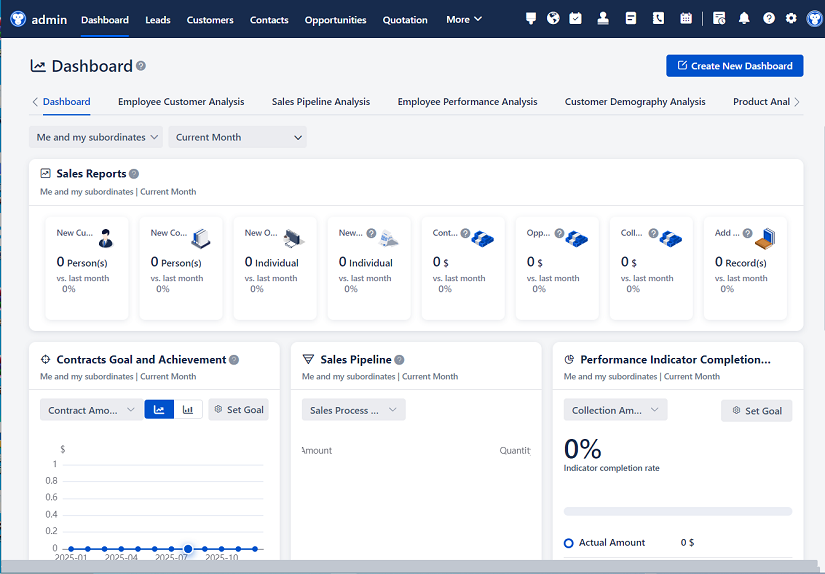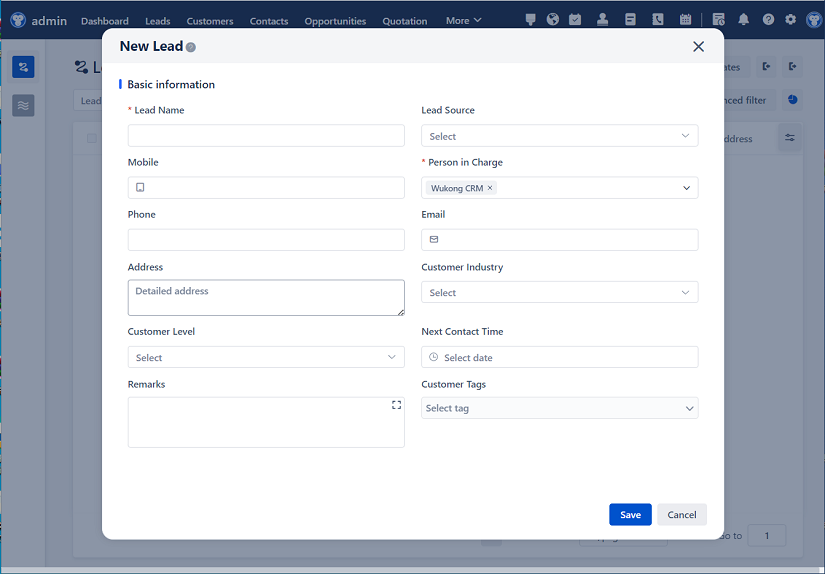
△Click on the top right corner to try Wukong CRM for free
You know, I’ve been thinking a lot lately about how businesses actually use CRM systems in the real world—not just the theory or the sales pitches, but the real, messy, day-to-day applications. It’s one thing to hear that Salesforce or HubSpot can “transform customer relationships,” but it’s another to see how that plays out when actual people are using it under pressure, with tight deadlines and real customers on the line.
So, let me tell you about this company I came across—let’s call them TechFlow Solutions for now. They’re a mid-sized IT services provider based in Austin. A few years ago, they were drowning in spreadsheets, sticky notes, and endless email threads. Sales reps couldn’t track follow-ups, support tickets got lost, and marketing had no idea which leads were hot. Sound familiar? Yeah, I thought so.
Then they decided to bite the bullet and implement a full CRM system—Salesforce, to be exact. Now, don’t get me wrong—it wasn’t some magical overnight fix. In fact, the first three months were kind of a disaster. People didn’t want to log in, they hated entering data, and half the team kept asking, “Why can’t we just go back to Outlook?”
But here’s the thing: their leadership didn’t give up. They brought in a change manager, ran weekly training sessions, and even tied small bonuses to CRM usage. Slowly but surely, people started seeing the value. The sales team realized they could finally see the entire history of a client in one place. No more digging through old emails. Support teams could tag recurring issues and escalate faster. Marketing began segmenting leads based on behavior tracked in the CRM.

And guess what happened after six months? Their lead conversion rate went up by 38%. Not because the software was magic, but because everyone was finally working from the same playbook.

Now, let’s switch gears for a second and talk about a completely different industry—a retail chain called UrbanThreads. These guys have 45 stores across the Midwest, selling trendy apparel. Before CRM, their customer data was all over the place. Online purchases weren’t linked to in-store visits. Loyalty points were managed in a separate system. If you returned an item without your receipt, good luck proving you bought it.
They ended up going with Microsoft Dynamics 365. Why? Because it integrated well with their existing e-commerce platform and point-of-sale systems. That integration piece is huge, by the way. So many companies pick a CRM just because it’s popular, but if it doesn’t connect with what you already use, you’re setting yourself up for frustration.
Anyway, once UrbanThreads got everything synced up, things started clicking. Store associates could pull up a customer’s purchase history on a tablet right on the floor. “Oh, you bought these jeans last month? We just got a new color in.” That kind of personal touch made customers feel seen—and they responded by spending more.

Plus, their marketing team started sending hyper-personalized emails. Instead of blasting “20% off everything” to everyone, they’d send messages like, “We noticed you liked floral dresses—here’s a preview of our new spring collection.” Open rates jumped from 18% to 47%. That’s not luck—that’s data-driven relevance.

But look, not every story has a happy ending. I remember talking to someone at a B2B manufacturing firm—let’s say Apex Industrial—who tried implementing Zoho CRM. They had high hopes. The price was right, the interface looked clean, and the sales rep promised seamless migration.
Spoiler alert: it wasn’t seamless.
Their product catalog had thousands of SKUs with complex pricing tiers based on volume, region, and contract terms. Zoho struggled to handle the logic. Custom fields kept breaking. Reports were inaccurate. After nine months of headaches, they ended up switching to SAP CRM, which cost way more but actually handled their complexity.
The lesson? Know your business needs before picking a CRM. Don’t fall in love with the demo. Ask, “Can this handle our workflows?” Because no matter how slick the UI is, if it can’t manage your real-world processes, it’s just digital clutter.
Let me share another example—one that surprised me. A nonprofit organization, GreenRoots Initiative, implemented HubSpot CRM. At first, I was skeptical. Nonprofits usually operate on shoestring budgets, and CRMs can be expensive. But HubSpot offers a free version with solid features, and they used it brilliantly.
They tracked donor interactions, set reminders for follow-up calls, and automated thank-you emails after donations. What really impressed me was how they used the CRM to map donor journeys. They could see who attended events, opened newsletters, or shared campaigns on social media. Then they personalized outreach accordingly.
One donor gave
And it wasn’t just about fundraising. Volunteers were also logged in the system. Coordinators could match skills to opportunities—like assigning bilingual volunteers to community outreach events. Retention improved because people felt more connected and appreciated.
Now, here’s something people don’t talk about enough: user adoption. It doesn’t matter how powerful your CRM is if nobody uses it properly. I’ve seen companies spend tens of thousands on software, only to have employees enter fake data just to check a box.
So what works? Culture. Training. Simplicity. One company I worked with—MediCare Plus, a regional healthcare provider—used a phased rollout. They started with just two departments: patient intake and billing. Once those teams saw benefits—fewer missed appointments, faster claims processing—they became advocates. Other departments started asking, “Hey, can we get on that system too?”
They also made data entry as painless as possible. Used mobile forms, voice-to-text for notes, and pre-filled templates. When it’s easy, people actually do it.
Another key factor? Leadership buy-in. If the CEO isn’t using the CRM, why should anyone else? At MediCare Plus, the COO reviewed CRM dashboards in every leadership meeting. That sent a clear message: this tool matters.
Let’s talk metrics for a sec. How do you know if your CRM is working? Well, it’s not just about “Are we using it?” It’s about outcomes. Are sales cycles shorter? Is customer satisfaction higher? Are support tickets resolved faster?
One SaaS company I followed—CloudPulse—tracked NPS (Net Promoter Score) before and after CRM implementation. Pre-CRM, their average NPS was 32. After one year of using Zendesk Sell with integrated feedback tools, it jumped to 61. Customers said they felt “more understood” and “better supported.”
And internally? Reps spent 12 hours less per week on admin tasks. That’s almost a full workday saved every week—time they could spend selling or helping customers.
But here’s a twist: sometimes the biggest wins aren’t obvious at first. Like at a travel agency—WanderWell Adventures—that used Pipedrive. Their main goal was to streamline booking follow-ups. But what they didn’t expect was how much better collaboration became.
Agents could see who was handling which client, add internal notes, and tag managers for approvals—all within the CRM. No more “Did you email them yet?” or “I thought you were calling today.” Miscommunications dropped, and client response times improved dramatically.
They even started sharing travel tips and destination updates inside the CRM, turning it into a knowledge hub. That kind of organic collaboration? You can’t plan for it, but it’s priceless.
Now, let’s address the elephant in the room: cost. Yes, CRMs can be expensive. Licensing, customization, training, maintenance—it adds up. But think of it as an investment, not a cost. One study found that businesses see an average return of $8.70 for every dollar spent on CRM. That’s not chump change.
And it’s not just about revenue. Think about employee morale. When your team isn’t wasting time searching for information or repeating tasks, they’re happier. Less burnout. More focus on meaningful work.
Of course, no system is perfect. Data quality is always a challenge. Garbage in, garbage out, right? I’ve seen CRMs full of duplicate entries, outdated contact info, and incomplete records. That’s why regular audits and cleanup are essential. Some companies schedule quarterly “CRM hygiene days”—dedicated time to review and correct data.
Integration is another hurdle. Your CRM shouldn’t be a silo. It needs to talk to your email, calendar, ERP, marketing automation, and support tools. APIs help, but they require technical know-how. That’s why having an internal tech champion—or partnering with a good consultant—can make or break the project.
And let’s not forget mobile access. People aren’t chained to desks anymore. Sales reps are on the road, service agents are in the field. A CRM that doesn’t work smoothly on phones and tablets is basically useless in today’s world.
One last story: a family-owned restaurant group—TasteLocal Eats—used a lightweight CRM (Capsule CRM) to manage their private dining clients. Nothing fancy. But they tracked preferences—“Mr. Chen hates cilantro,” “The Patel family always wants a corner booth”—and used that to surprise guests with little touches. Free dessert on anniversaries. A welcome note with dietary restrictions pre-confirmed.
Word spread. These clients started bringing friends. Revenue from high-value bookings went up 29% in a year. All because they treated customer data like a relationship tool, not just a database.

So, what’s the takeaway? CRM systems aren’t just software. They’re enablers of better human connections. When used right, they help us remember names, honor preferences, anticipate needs, and build trust.
It’s not about automating everything. It’s about empowering people—with information, context, and time—to do their best work.
At the end of the day, technology should serve people, not the other way around. And a well-implemented CRM? It does exactly that.
FAQs (Frequently Anticipated Questions):
Q: Do small businesses really need a CRM?
A: Honestly? Yes, especially if you’re growing. Even a simple CRM helps you stop losing leads and keeps your team aligned. You don’t need Salesforce-level power—start small and scale.
Q: How long does it take to see results after implementing a CRM?
A: Most companies start seeing improvements in 3–6 months, but full ROI often takes 12–18 months. Patience and consistent usage are key.
Q: What’s the most common mistake companies make with CRM?
A: Skipping proper training and change management. Buying the software is just step one. Getting people to use it correctly? That’s the real challenge.
Q: Can a CRM improve customer satisfaction?
A: Absolutely. When your team has full visibility into a customer’s history, they can respond faster and more personally. That builds loyalty.
Q: Should we customize our CRM heavily?
A: Be careful. Too much customization makes upgrades harder and can break things. Focus on configuring what’s built-in first—only customize when truly necessary.
Q: Is cloud-based CRM safer than on-premise?
A: Modern cloud CRMs often have better security than on-premise systems—regular updates, encryption, backups. But always check compliance requirements for your industry.
Q: How do we ensure data accuracy in our CRM?
A: Set clear data entry rules, assign ownership, audit regularly, and make it easy to update records. Also, incentivize good habits—maybe even gamify it a little.
Q: Can CRM help with remote teams?
A: Totally. In fact, it’s a game-changer for distributed teams. Everyone stays on the same page, no matter where they’re logging in from.
Related links:
Free trial of CRM
Understand CRM software
AI CRM Systems

△Click on the top right corner to try Wukong CRM for free